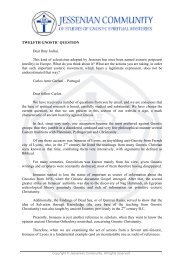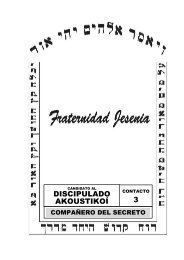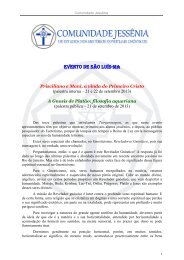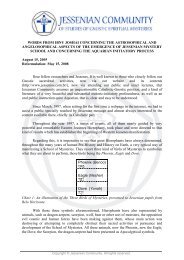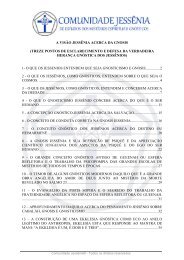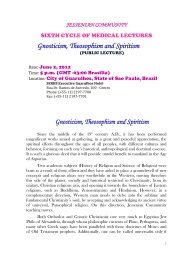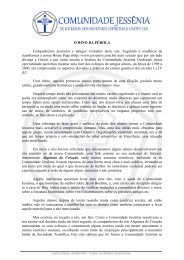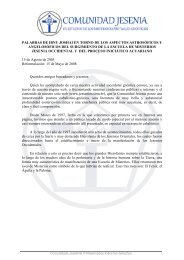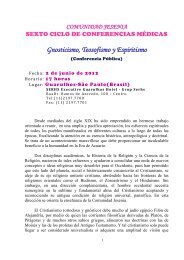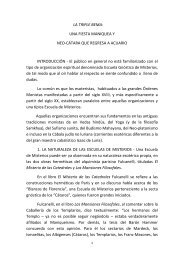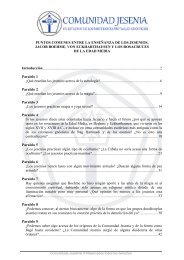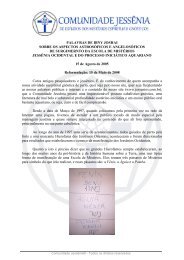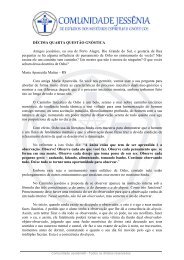JESSENIC VIEW ON GNOSIS (THIRTEEN POINTS OF ...
JESSENIC VIEW ON GNOSIS (THIRTEEN POINTS OF ...
JESSENIC VIEW ON GNOSIS (THIRTEEN POINTS OF ...
You also want an ePaper? Increase the reach of your titles
YUMPU automatically turns print PDFs into web optimized ePapers that Google loves.
Jessenic View on Gnosis<br />
that was the Mystery of the Psychopompy belonging to the Cathars, Bogomils, Mandeans,<br />
Egyptians and Tibetans, and thus actually a dangerous art for connecting the pupil to the<br />
world of the dead.<br />
Several times we have been exposing in our website that Jessenes, likewise all ancient<br />
Gnostics, are anti-cosmics, in other words, do not have any kind of tie with aeonic cosmos<br />
encircling Kenoma which forms the sevenfold valley of the death, described in Psalm 23.<br />
However, in this time, we shall be more succinct, given the raise among some modern<br />
Gnostics in the suspicions that we are practicing a sort of mediumistic or aeonic magic and<br />
teaching it in our four volumes of commentary on the Gospel of Pistis Sophia.<br />
Going towards the magnificent Jungian insights concerning the mythological (or<br />
apocalyptical) role of the relationship between human Psyche and the Paraclete, we have to<br />
present something inedited to a certain extent in dualistic esotericism, specially in that we call<br />
Gnostic.<br />
In the part 749 of the book Answers to Job, Jung, although seen himself as a layman in<br />
Theology, dares to claim that ‘protestantism, by denying the myth even more than the<br />
catholicism, has lost contact to the momentous archetypical transformations which occur in a<br />
Soul of a person... as well as in the symbols...’.<br />
Dear Gnostic fellows who presently does not feel comfortable with our modern and<br />
Gnostic art of merging history with myth and surrounding them with symbols Gnostically<br />
employed in many experiences of our Mystery Initiatory practice: as a Paracletian Church, we<br />
wish, by using such routines, to open the mind and Psyche of our pupils, as the ancient<br />
Gnostic Initiations did, among which the Valentinian and Manichaean, to the profound<br />
transformations Jung names archetypical, connecting both the soul and mind of our pupils to<br />
the profound experiences regarding Pistis Sophia’s drama, i.e. the divine drama of the soul<br />
immersed in the earthly side of Kenoma and fenced by the subtle aspect of the Reflecting<br />
Sphere.<br />
To those same Gnostics who feel uncomfortable with our doctrine and practice, and<br />
repudiate the nocturne visionary experiences of Jessenian Gnosis, by claiming they are<br />
‘events caused by a tie or association with the Reflecting Sphere, all of them being of illhealth<br />
nature’ we restate the words of Jung: ‘protestantism [protestantism, lo and behold!]<br />
seems to be succumbed to a rationalist historicism, loosing the sensitivity to the presence of<br />
the Holy Spirit actuating in the most recondite of our Soul. Thus, it is incapable of<br />
understanding or accepting a new revelation of divine mythical drama of the Soul.’<br />
What you are calling association with the Reflecting Sphere is, in fact, as explained by<br />
that ingenious modern Gnostic named Jung, an initiatory opening whose routine we have<br />
withdrawn from Gnostic treasure of the esotericist Christian great teachers from past,<br />
supporting each Jessenic Soul nocturnally to experience in a intense way its connection to the<br />
Paraclete or Holy Spirit through symbols and sacred gestures from the Initiation of the Five<br />
Sealings of Mysteries, and thus, to experience, as Pistis Sophia, the thirteen agonies for the<br />
imprisonment of every Soul fallen in Kenoma, an experience that anticipates these Souls the<br />
content of the experiences they will have to confront in future, when, free from biological life,<br />
crossing the seven gates of death until reaching in the place of the double Tetrad, or the place<br />
of the Ogdoad, Wholeness or Pleroma.<br />
26




